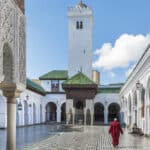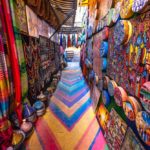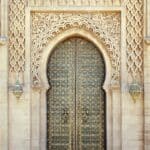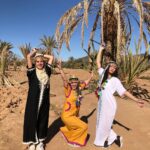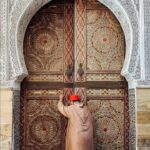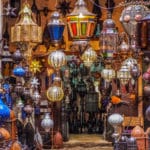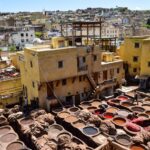
Table of Contents
Fes Morocco Travel Guide Attractions
Discover the essence of Fes, with our comprehensive Fes Morocco Travel Guide. Before you embark on your journey to Fes, Morocco, learn all the essential details to make the most of your visit. Fes is a pivotal stop on any Moroccan adventure, akin to exploring the vast Sahara desert or vibrant Marrakech.
Check our private tours from Fes
Formerly the capital of Morocco until 1912, Fes remains a vital hub of spirituality and culture in the country. Its rich history spans over 1,200 years, evident in its array of palaces, museums, mosques, and labyrinthine alleyways within the Medina. Fes beckons with a sensory overload that encapsulates the essence of Morocco.
Immerse yourself in the bustling chaos of Fes, where every corner teems with enticing aromas, bustling markets, and delectable food stalls. While the experience might be intense and mentally taxing, it offers unparalleled beauty and charm. Embark on a journey that transports you back in time, allowing you to explore Fes as a local rather than a mere tourist.
The Medina of Fes, with its intricate labyrinthine layout, promises an adventure of its own. Lose yourself amidst the narrow streets, numbering over 9,000, and relish the thrill of finding your way through this ancient cityscape.
Zaouia de Moulay Idriss
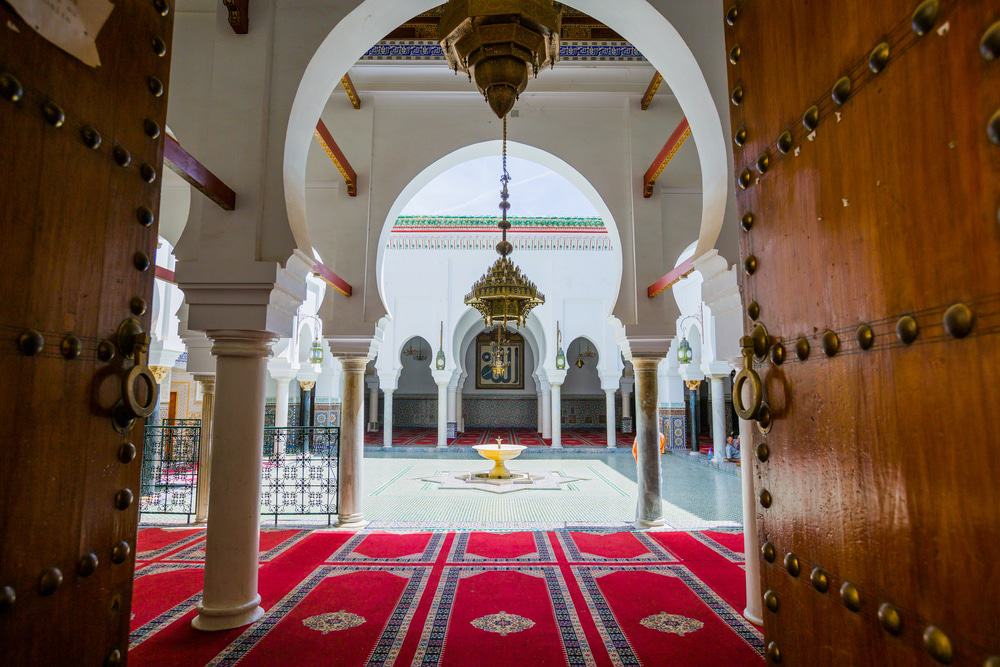
The Zaouia Moulay Idriss II serves as a shrine and religious complex housing the tomb of Idris II, a key figure in Moroccan history who ruled from 807 to 828. Regarded as the primary founder of Fes and the first Moroccan Islamic state, his legacy is revered in this sacred space.
In 1308, nearly five centuries after Idris II’s passing, an uncorrupted body was discovered at the site, believed to be his. This led to the establishment of the zaouia, initially constructed by the Marinids around 1440. Over time, the building underwent significant modifications, culminating in extensive restoration during the 18th century under Moulay Ismail, reflecting the architectural style of the Alaouite dynasty.
Moulay Idriss II holds a special place as the patron saint of Fes, with his zaouia believed to offer blessings to visitors, particularly newcomers to the city, young boys before circumcision, and women seeking aid during childbirth.
Know Before You Go: Non-Muslims are typically not permitted inside the zaouia, but you can still appreciate its intricate tile work and carvings from the exterior. Take time to explore the various entrances to catch different perspectives of the building’s beauty.
Opening Hours: Daily: 8am-12pm / 2-6pm
Palais Royal Dar El Makhzen
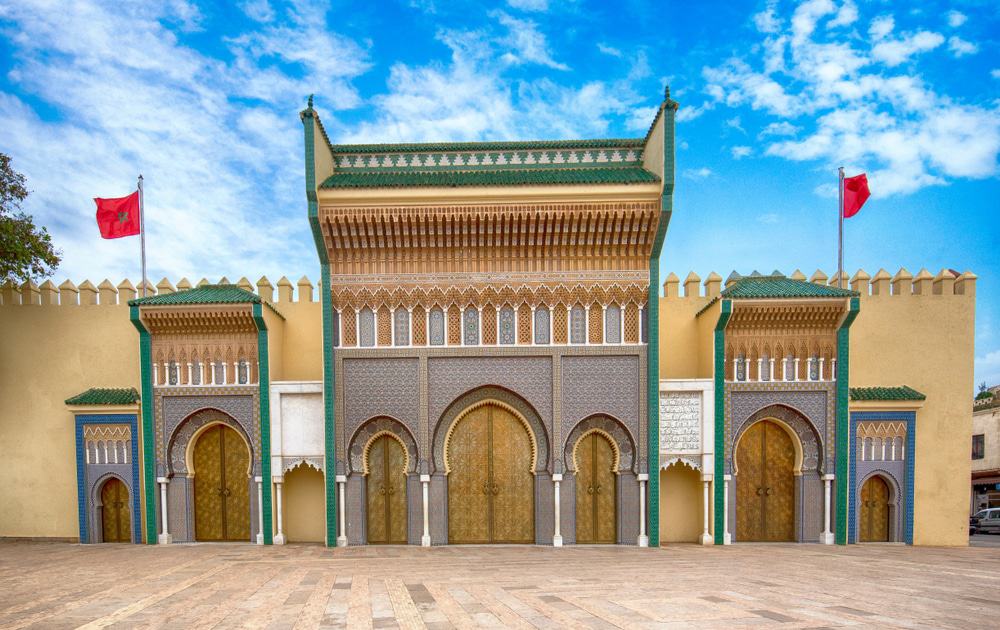
Although the Royal Palace (Dar al-Makhzen) is not open to the public, its magnificent doors make for an excellent photo opportunity and are certainly worth admiring. Located in Fes el-Jdid and dating back to the 13th century, these intricately decorated doors showcase the exquisite patterns of Moroccan design.
Know Before You Go: While the Palais Royal Dar El Makhzen isn’t accessible to visitors, its seven stunning bronze doors provide a fantastic backdrop for capturing memorable photos.
Dar Batha
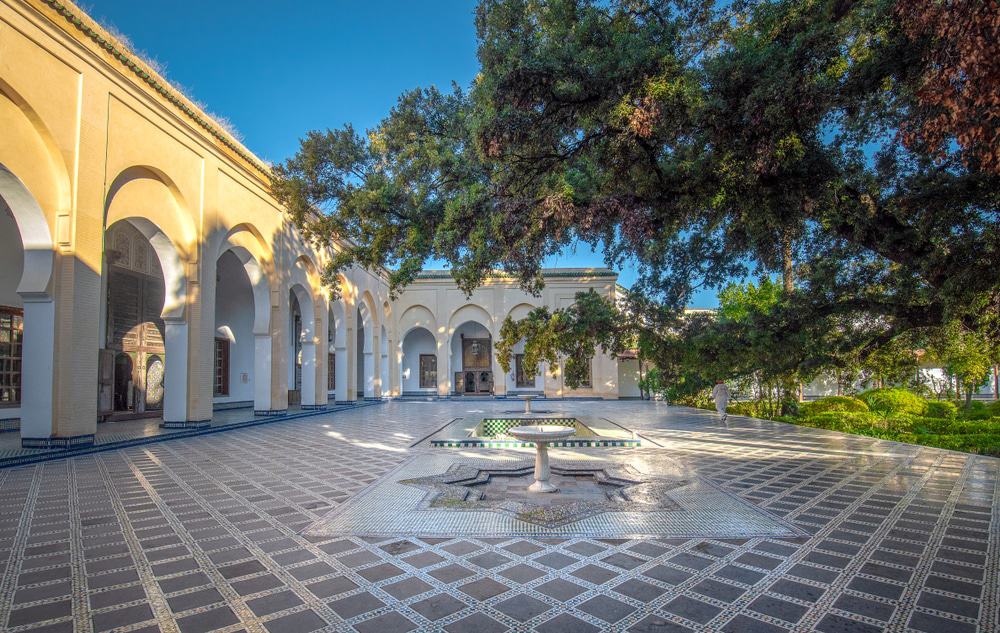
Nestled in the heart of the Medina of Fez, Dar Batha has undergone a fascinating transformation since its inception. Converted into a museum in 1915, it now boasts a remarkable collection of around 6,000 pieces, ranging from traditional Moroccan tiles to carpets and astrolabes.
Originally selected during the reign of Sultan Hassan I (1873-1894), Dar Batha was constructed in the Arab-Andalusian style, featuring a serene garden and exquisite decorations. Initially serving as a venue for entertaining guests, it retained this function during the reign of Hassan I’s son, Abdelaziz.
In 1912, representatives of the French Protectorate took control of Dar Batha, using it as their headquarters until relocating to Rabat. Subsequently, the building was repurposed as a museum, becoming Morocco’s first in 1915, initially focusing on national art.
Today, Dar Batha houses an impressive array of Moroccan art, craftsmanship, and historical artifacts. Highlights include exquisite examples of Moroccan woodcarving, traditional zellige tilework, and sculpted plasterwork known as tadelakt, sourced from the city’s ancient madrasas. Visitors can also marvel at Berber carpets, Fassi embroidery, antique coins, instruments, and a captivating display of astrolabes, ancient scientific instruments used for celestial navigation.
Arguably, the most captivating exhibit is the museum’s collection of ceramics, showcasing the renowned blue pottery of Fez. Originating in the 10th century, artisans in Fez crafted ceramics with intricate blue patterns using cobalt glaze, establishing a tradition now synonymous with Fez Blue.
Know Before You Go:
Dar Batha is located along Rue de la Musée, not far from the Bab Boujeloud, the ornate city gate that is known as the main western entrance to Fes el Bali (the oldest walled part of Fez). The museum and grounds are open every day apart from Tuesday from 9 a.m. to 5 p.m. The entrance fee is 20 dirhams (about $2 USD). More than half of the palace grounds are taken up by the Andalusian-style gardens, which offer a peaceful respite from the busy medina outside, and the chance to drink some tea and try some traditional sweets.
Chouara Tannery
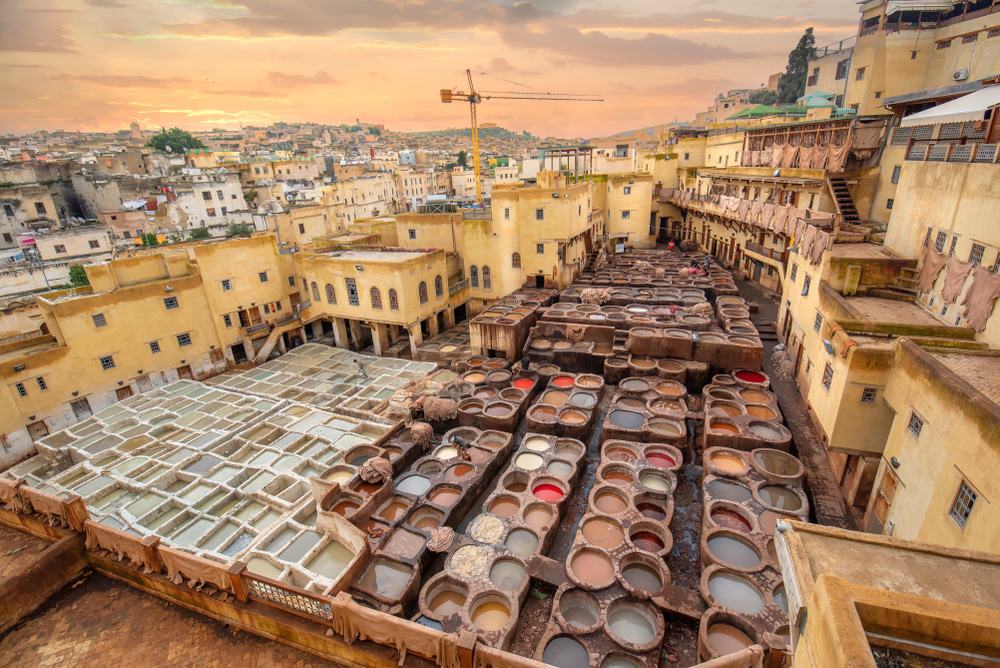
At the Chouara tanneries, hides undergo traditional preparation methods, steeped in history. They’re immersed in limestone vats filled with a mixture of pigeon excrement and donkey urine, then meticulously hand and foot-beaten before being dyed with natural colors.
Among the hues, yellow leather stands out, achieved through saffron dyeing. This prized leather is often fashioned into the iconic pointed slippers known as babouche. However, it’s essential to brace yourself for the pungent odors permeating the air. Visitors are typically offered sprigs of mint upon arrival to help mask the smell.
Know Before You Go:
Prepare for strong odors.
Nejjarine Fondouk
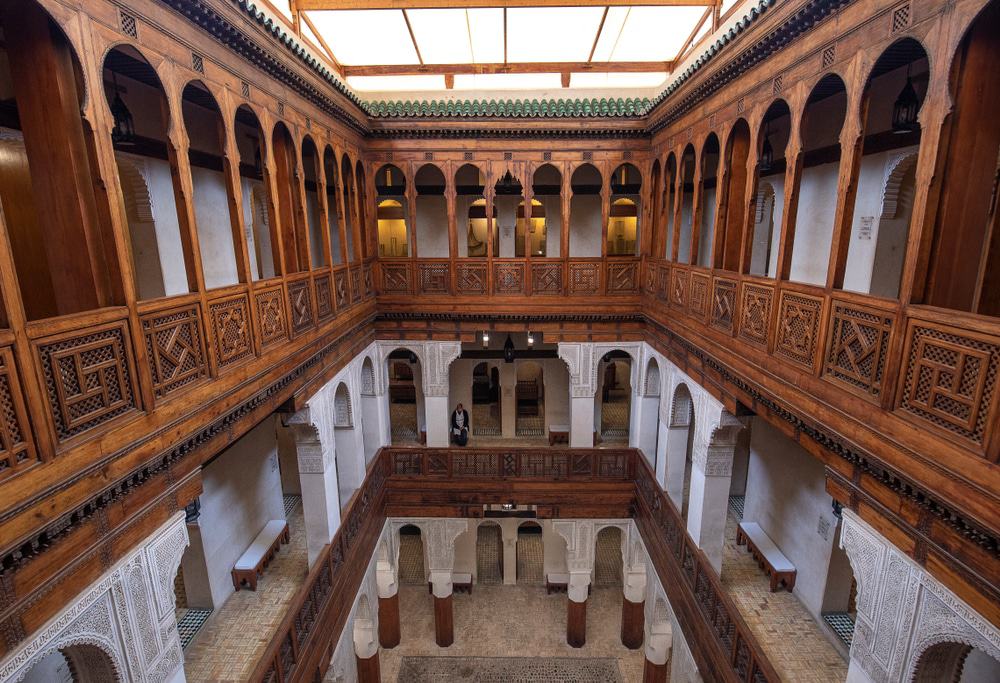
The ancient Medina of Fez, Morocco, is a treasure trove of history and culture, showcasing the rich traditions of the Moroccan people. Among its many attractions is Fondouk el-Nejjarine, home to the Museum of Wooden Arts and Crafts. Located near the Henna Souk area of Fez el-Bali, this museum celebrates the skill of woodcarvers and artists through its intricate decorations and displays.
Originally built in the 18th century as a caravanserai, Fondouk el-Nejjarine provided a resting place for travelers journeying through Fez. Following the typical Moroccan architectural style, the building surrounds an internal courtyard with a fountain, offering respite from the heat. Its upper floors boast beautifully carved wooden arches and railings, providing visitors with a view of the courtyard below.
Morocco has successfully preserved its age-old traditions and crafts, including Tadelakt, woodwork, and woodcarving. Various types of timber, such as oak, mahogany, acacia, and cedar, are utilized in Moroccan woodcarving, with cedar being particularly popular due to its availability and durability.
Woodwork in Moroccan architecture serves as both artistic expression and a reflection of Islamic culture and tradition. This ancient skill has been passed down through generations and remains vibrant in cities like Marrakech, Tetouan, Essaouira, Meknes, and Fez. Visitors exploring the Medina of Fez will encounter artisans practicing this craft, creating practical yet beautiful items.
A visit to Fondouk el-Nejjarine is highly recommended for those exploring Fez, offering a splendid example of traditional Moroccan craftsmanship.
Marinid Tombs
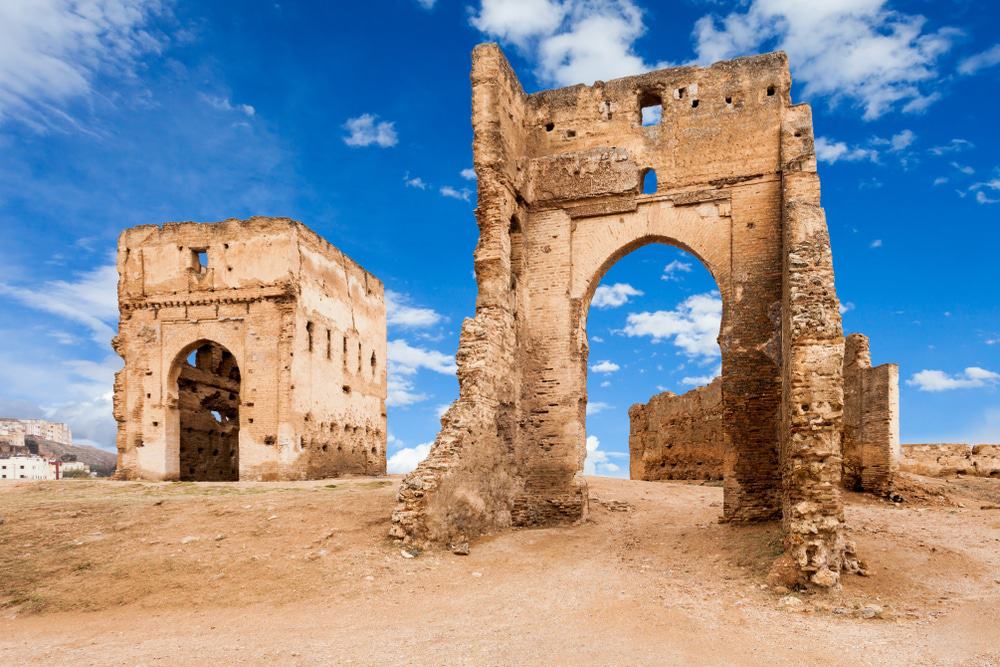
For the ultimate panoramic view of the Fez Medina, head to the Merenid Tombs, dating back to the 14th century. Once grand resting places for the Merenids, these tombs have weathered conquests and looting, losing much of their original splendor. However, the vista they offer more than compensates for their diminished aesthetics.
From the tombs, you’ll witness the sprawling expanse of the Fez Medina unfurling to the East, a mosaic of minarets, laundry lines, satellites, and occasional fires. Carved into the hillsides are man-made caves, serving as dwellings for some of Fez’s less fortunate residents. Evidence of late-night gatherings is scattered about, while locals caution that the area is known for muggings, particularly targeting outsiders.
Directly below the tombs, two large graveyards double as grazing grounds for local shepherds, though unfortunately, the area is marred by litter. Despite this, the eerie atmosphere is enhanced by scattered animal bones.
Know Before You Go:
Easily accessible with a 15-minute walk, the Merenid Tombs are adjacent to Hotel Les Merenides.
Bou Inania Madrasa
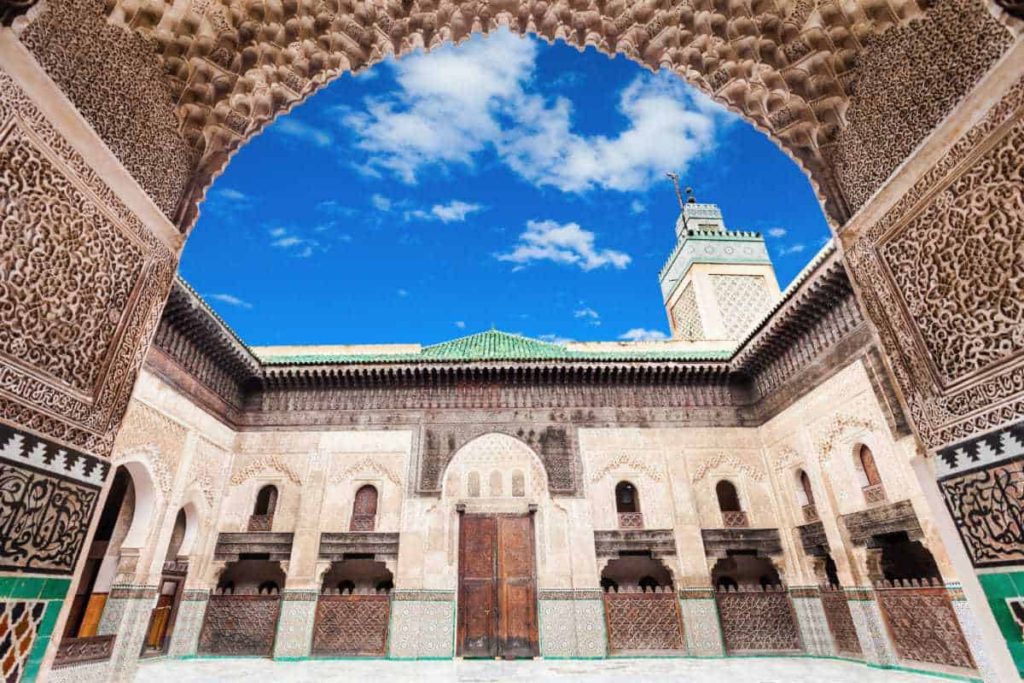
Established between 1351 and 1356 AD by Abu Inan Faris, who also founded the Bou Inania Madrasa in Meknes, this madrasa stands as a remarkable specimen of Marinid architecture. Its name, “Bou Inania,” is derived from the first part of the sultan’s name, “Abou Inan.” Serving as both an educational institution and a congregational mosque, it holds the distinction of being the only madrasa in Fes with a minaret.
Opposite the main entrance lies the dar al-wudu (ablutions house), while classrooms flank the central courtyard. Advised by religious leaders of the Karaouine Mosque, Abu Inan Faris constructed this madrasa, which became the final one erected by the Marinids. It subsequently rose to prominence as one of Fes and Morocco’s most significant religious establishments, ultimately attaining the status of a Grand Mosque.
Renovations were undertaken in the 18th century, with Sultan Mulay Sliman overseeing substantial reconstructions. In the 20th century, extensive restoration work focused on the structural integrity, as well as the intricate plaster, wood, and tile decorations featuring Islamic geometric patterns.
Unlike many religious sites in Morocco, the Madrasa Bou Inania welcomes non-Islamic visitors. Across from it stands the Dar al-Magana, boasting a hydraulic clock that was constructed concurrently with the madrasa.
Know Before You Go:
Experience the pinnacle of Moorish architecture, art, mathematics, medicine, and philosophy from the 14th century.
While the tour is relatively brief, don’t miss the opportunity to explore the exquisitely adorned courtyard, showcasing intricate wood carvings and vibrant tile work.
Opening Hours:
Saturday to Wednesday: 9am-5pm; closed during prayer times.
Al Attarine Madrasa
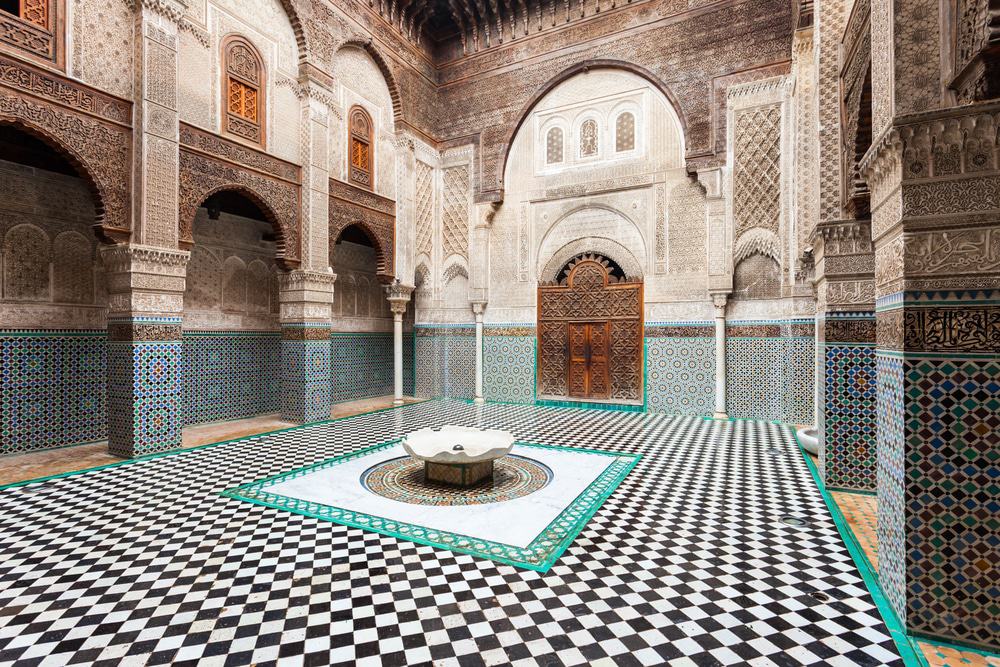
Dating back to the 14th century, the al-Attarine Madrasa is situated at the gateway of a bustling spice and perfume market in Fez, Morocco’s spiritual hub and second-largest city. Renowned for its stunning courtyard adorned with traditional Marinid patterns, this small madrasa is a testament to the dynasty’s patronage of religious learning.
Commissioned by Sultan Abu Sa’id Uthman II of the Marinid Dynasty between 1323 and 1325, the madrasa derives its name, meaning “the madrasa of the perfumers,” from its proximity to the historic market. Despite bordering a bustling souk, the al-Attarine Madrasa offers a serene ambiance.
Central to the madrasa is a beautifully adorned rectangular courtyard leading to a square prayer hall. Surrounding them are simple student accommodations, contrasting starkly with the intricate architecture of the courtyard and prayer hall, which draw visitors from far and wide.
The courtyard exemplifies Marinid craftsmanship, featuring walls embellished with carved stucco, Arabic calligraphy, and vibrant zellige mosaic tiles forming intricate geometric patterns. Marble columns support elaborately carved wooden arches and cornices, showcasing remarkable detail and delicacy. The tiled floor, though simpler, also boasts geometric patterns considered sacred.
Know Before You Go:
Located along Rue Talaa Kebira in the Fez Medina, near the Kairaouine Mosque and University, the al-Attarine Madrasa is open daily from 8 a.m. to 6 p.m. It’s advisable to check for any religious events that may alter public access hours. Admission is 20 dirhams (approximately $2 USD) for individuals or 15 dirhams per person for groups of 10 or more.
Blue Gate
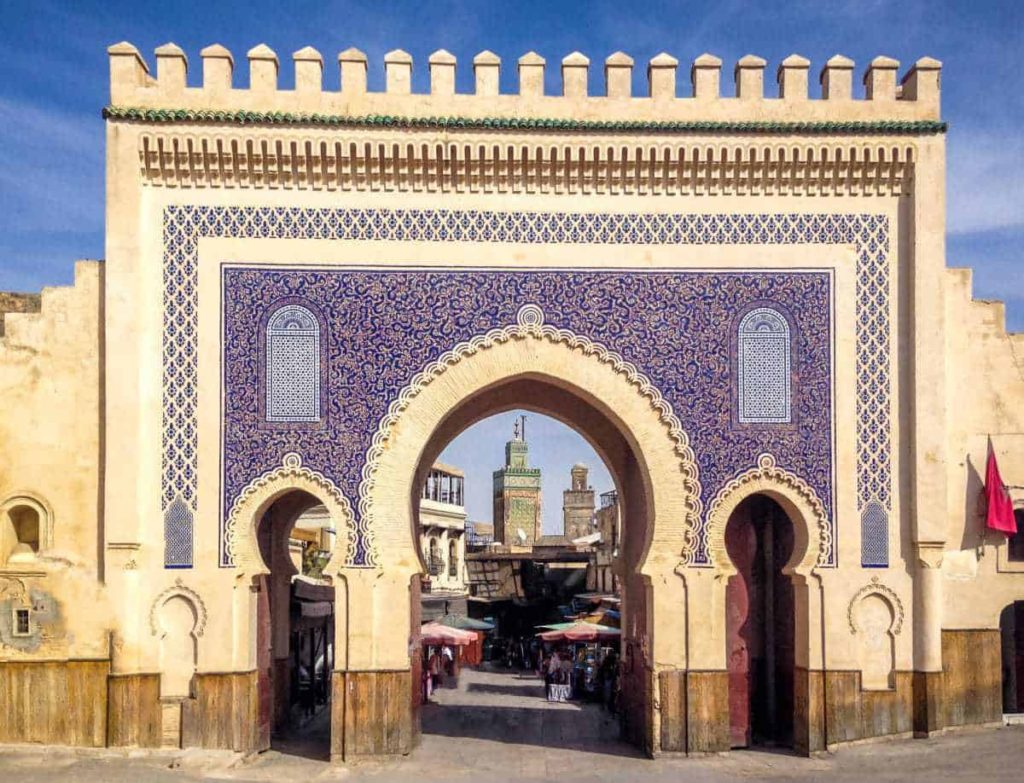
When you visit Fes, Morocco, one of the first landmarks you’ll encounter is the Grande Porte Bab Boujeloud, also known as “The Blue Gate of Fes.” This magnificent entrance marks the gateway to the old medina, Fes el-Bali, which is the world’s largest surviving medieval city and a car-free zone. The blue side of the gate, facing outward, symbolizes the city’s renowned pottery adorned with elegant cobalt blue designs. On the other side, facing the medina, the gate is green, representing the color of Islam.
Constructed in 1913, the Bab Boujeloud serves as a passage between two vibrant and diverse worlds—the bustling modernity outside and the captivating mix of eras within the medina. As you pass through “The Blue Gate,” the sounds of traffic fade away, replaced by the bustling activity of shopkeepers and the shuffling footsteps of pedestrians and animals navigating the maze-like alleyways.
From the entrance of Bab Boujeloud, you’ll encounter the two main alleyways leading into the medina, Tala’a Kbira and Tala’a Sghira. Regardless of which path you choose, getting lost amidst the enchanting labyrinth of Fes el-Bali is almost inevitable.
University of Al-Karaouine
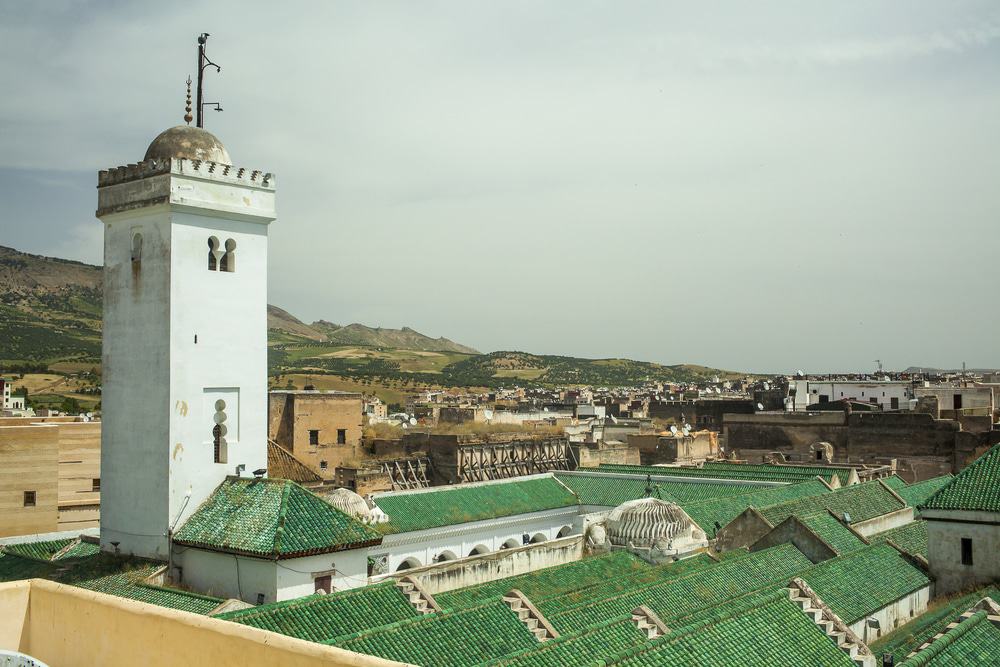
The University of Al-Karaouine, also known as al-Quaraouiyine and al-Qarawiyyin, holds the distinction of being recognized by Guinness World Records and UNESCO as the oldest continuously operating degree-granting university globally. Situated amidst the labyrinthine alleyways of Fes el-Bali, Morocco, one of the world’s oldest living cities, Al-Karaouine exudes a sense of history and tradition.
Wandering through the university grounds today, visitors can appreciate its simple yet beautiful design adorned with Andalusian art and Kufic calligraphy. The university library preserves numerous precious manuscripts, including historic copies of the Qu’ran.
In 859, Fatima al-Fihri used her inheritance to construct a mosque and associated school, known as a madrasa, as a gesture of gratitude to the community that welcomed her family. Hailing from the Tunisian city of Kairouan, the mosque and university bear its namesake. The mosque, initially accommodating 22,000 worshippers, remains the largest in Africa. Contrary to common misconception, both men and women can attend the university, reflecting the growing cultural value of education.
Over the centuries, Al-Karaouine evolved into a prominent spiritual and educational center in the Muslim world. Initially focused on religious instruction and Qu’ran memorization, the curriculum expanded to include Arabic grammar, music, Sufism, medicine, and astronomy. The university underwent various transformations, integrating into the state education system in 1947 and introducing subjects like physics, chemistry, and foreign languages.
Despite facing a decline in student enrollment due to the emergence of Western-style institutes in Morocco, Al-Karaouine maintains its traditional approach to instruction. Students, ranging from ages 13 to 30, gather in semi-circles around a sheik for text readings. Before admission, they must have memorized the entire Qu’ran and other texts. The university attracts students from across Morocco, Islamic West Africa, and even Muslim Central Asia.
The University of Al-Karaouine serves as a reminder that the roots of university learning lie not in institutions like Oxford or Cambridge, but in the madrasa of a mosque that set the wheels of education in motion over a millennium ago.
Know Before You Go:
The university functions as a mosque, prohibiting entry to non-Muslim visitors. However, main gates and some entrances are accessible for observation but not entry.
Borj Nord
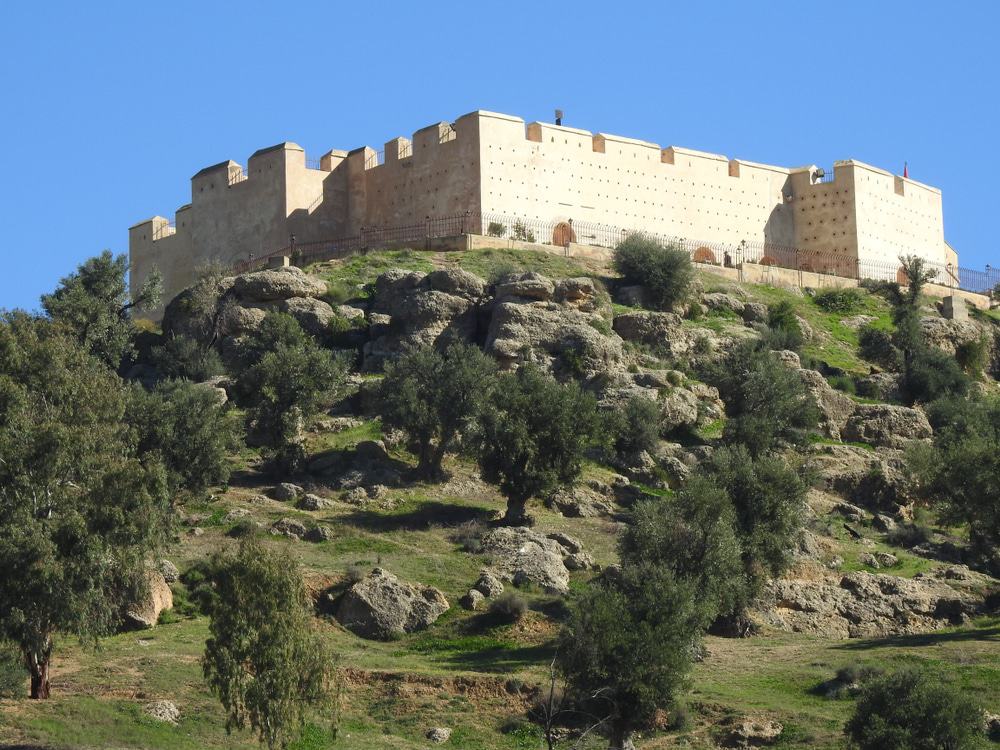
Constructed in 1582 under the patronage of Saadian Sultan Ahmed El Mansour Eddahbi, the Borj Nord fortress stands as a sentinel overlooking the city of Fes, Morocco. Originally built to safeguard the city during the Saadi dynasty, this grand structure was repurposed into an armory museum in 2016.
Today, the Borj Nord Arms Museum houses a remarkable collection of over 5,000 weapons, ranging from a colossal 12-ton cannon used in the historic Battle of Three Kings to nearly 800 military artifacts and archival photographs. Spread across thirteen rooms, the museum showcases a diverse array of historic armory, much of which was commissioned by royalty and includes rare pieces from Morocco and beyond.
Even for those not particularly interested in weaponry, the museum offers a captivating experience, providing stunning views of the Fes Medina from the nearby Merenid Tombs. Across the valley stands the Borj Sud fortress, the southern counterpart to Borj Nord, serving as another imposing military monument.
Know Before You Go:
The Borj Nord Arms Museum is open from Tuesday to Sunday, operating from 9 am to noon and from 2 pm to 6 pm.
Fes Morocco Travel guide Aben Danan Synagogue
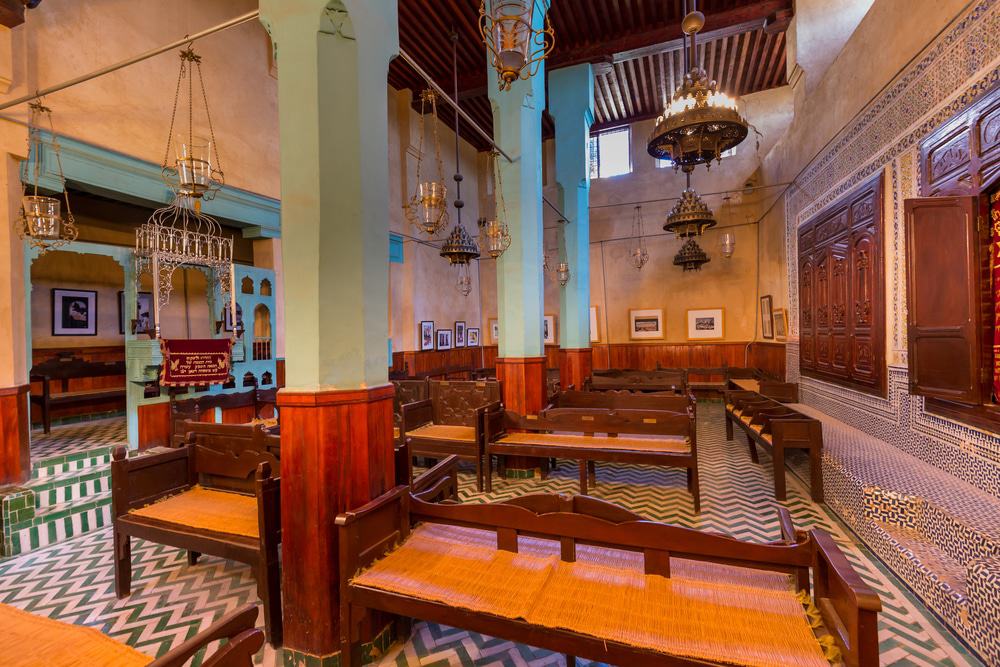
Located in Fes El Jadid El Mallah, Morocco’s first designated Jewish quarter established in 1438, the Ibn Danan synagogue stands as one of the region’s oldest synagogues. Constructed in the 1600s by the prominent Moroccan Jewish Ibn Danan family, this synagogue remains among the few surviving structures in this historic area.
The Ibn Danan synagogue, a testament to the thriving Jewish quarter of its time, showcases traditional Moroccan and Islamic design elements, including exquisite tiles, stucco work, and arched doorways. However, following World War II, the synagogue fell into disrepair, prompting a significant restoration effort in 1996.
Thanks to the collaboration between the World Monuments Fund, the Moroccan Ministry of Culture, the Judeo-Moroccan Cultural Heritage Foundation, and the local community, extensive restoration work was undertaken to conserve the synagogue’s deteriorating state. By 1999, the synagogue reopened its doors to the public.
Today, Ibn Danan is believed to be the only fully intact Moroccan synagogue, adorned with wooden benches, oil lamps, embroidered tapestries, and authentic Torah scrolls made from gazelle skin, offering visitors a glimpse into Morocco’s rich Jewish heritage.
Know Before You Go:
Centrally located in the mellah, it is advisable for visitors to enlist the services of a knowledgeable guide for a comprehensive tour of the synagogue.
El Glaoui Palace
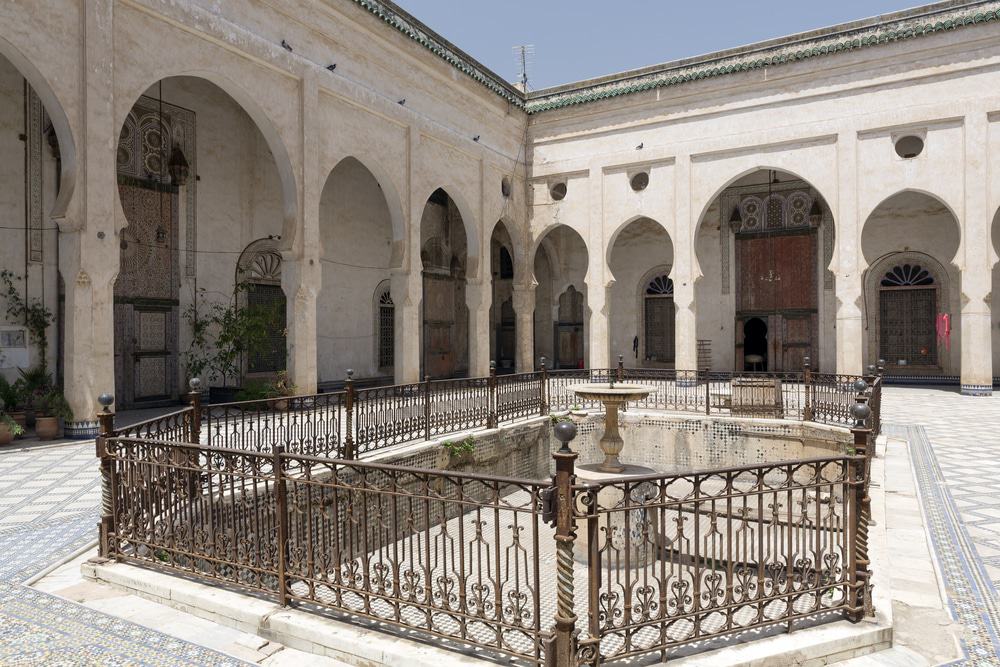
In the maze-like medina of Fes lies a hidden gem, offering a serene escape from the bustling streets and tourist hubs. This tranquil spot was once the residence of the last ruler of Fes, Thami El Glaoui, and is named after his family. Serving as the seat of power until his demise, the palace holds a special charm, particularly its picturesque courtyard.
At the heart of the palace lies a stunning marble fountain surrounded by a pool, providing a refreshing oasis from the scorching Fes heat. Adorned with intricate motifs, the rooms exhibit a blend of traditional and European influences, evident in the arched walls. While the architecture may not be grandiose, it still evokes a sense of regal splendor.
Although much of the palace’s former glory has faded, it retains an aura of its illustrious past under Glaoui’s rule. While exploring, take heed as the palace has not received proper maintenance, and some areas may pose risks.
Know Before You Go:
Finding the palace may require some searching, as it is not a mainstream tourist destination.
However, you’ll enjoy the benefit of avoiding crowds.
Exercise caution while navigating the premises due to the lack of proper maintenance.
Fes Morocco Travel guide Jnan Sbil Gardens
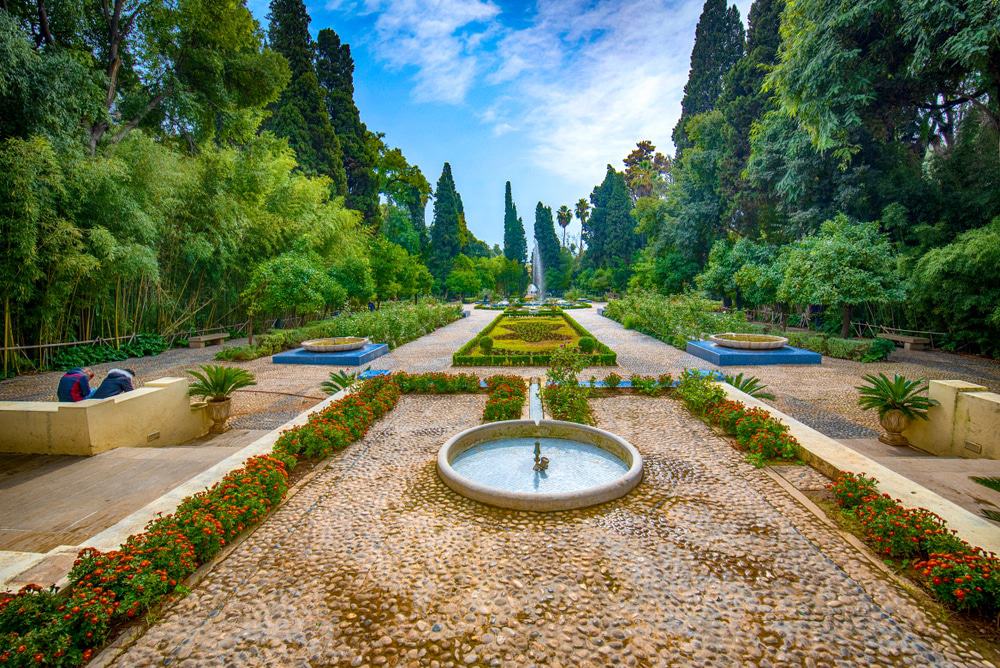
Fes offers more than just bustling old markets and historic houses. Just beyond the city walls lies the serene oasis of Jardin Jnan Sbil. Spanning 8 hectares, this garden provides a tranquil escape from the urban hustle and bustle.
Nestled amidst the busy streets of central Fes, Jardin Jnan Sbil exudes calmness and serenity. Developed in the Andalusian tradition, the garden flourishes despite the desert heat, offering a refreshing retreat even during the hottest parts of the day. Some of the trees here have been imported from distant lands like China and India, adding to the garden’s diverse charm.
After a day of exploring the lively medina, visitors can unwind in the peaceful ambiance of Jardin Jnan Sbil, making it an ideal spot for an evening relaxation session.
Know Before You Go:
The garden may be crowded in the evening, so plan accordingly for a serene experience.
Andalusian Mosque
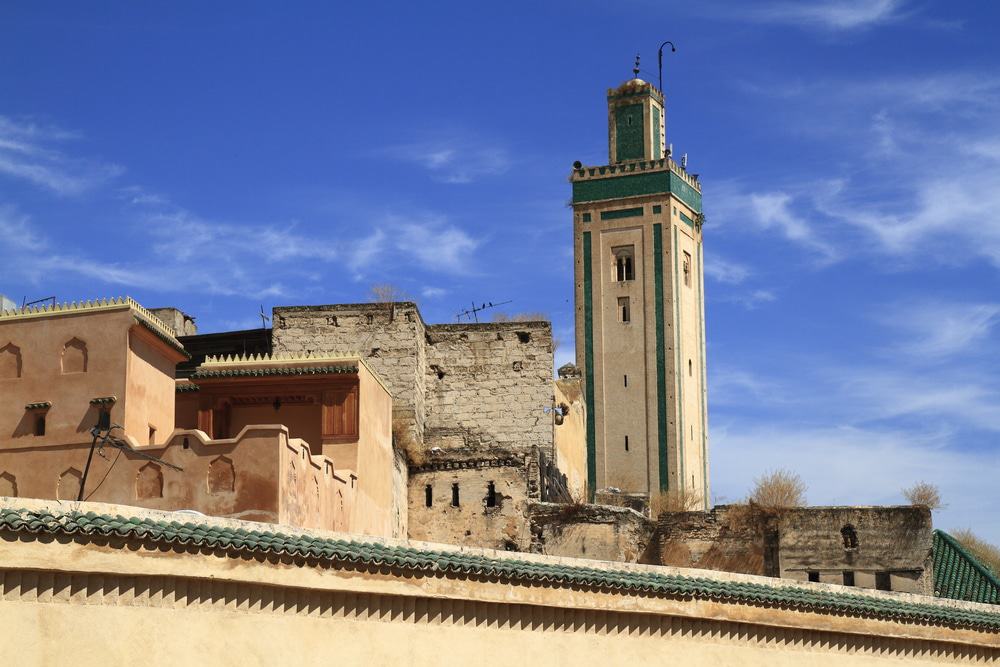
Constructed in 859-860 during the Idrissid dynasty reign, the Andalusian Mosque stands at the heart of the district bearing its name, thanks to El Fihriya Meryem, sister of Fatima El Fihriya, founder of the Al Quaraouyine Mosque. Originally a modest oratory serving as a Muslim place of worship, the mosque underwent several transformations over the centuries.
Various dynasties that ruled the kingdom contributed to the mosque’s restoration and beautification. In 956, a minaret resembling that of the Al Quaraouyine Mosque was added, symbolizing their perpetual rivalry. During the Almohad era, the mosque was nearly entirely reconstructed. Subsequently, the Merinids introduced enhancements such as a fountain in the inner courtyard and a library. Under the Alaouid dynasty, Moulay Ismail initiated extensive renovations.
Know Before You Go:
Access to the Andalusian Mosque is possible through the renowned tanneries or via Bab Ftouh gate.
Fes Morocco Travel Guide Place seffarine
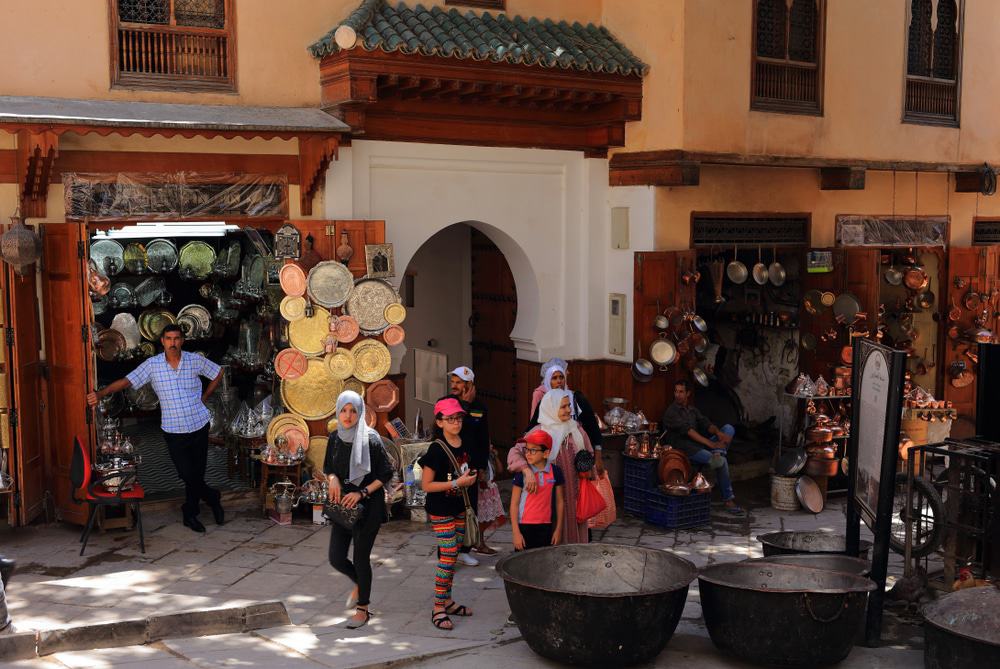
The plaza of Place Seffarine, characterized by the entrance to the al-Qarawiyin Library and an ancient sturdy tree, stands as one of the most enchanting spots in Fes. As you approach, the rhythmic tapping of copper beaters fills the air, drawing you in to explore the bustling stalls.
Take your time browsing through the stalls, where you’ll discover high-quality cookware perfect for souvenirs, including pixie pans for boiling milk, copper tagines and teapots, and intricately etched bowls for use in the hammam. Afterward, unwind at the café with a robust cup of coffee while observing the vibrant activity around you.
Alternatively, venture around the corner onto Derb Chouara for a taste of hot, sweet mint tea infused with various healing herbs at a cozy hole-in-the-wall spot. Here, you’ll mingle with local craftspeople enjoying a well-deserved break from their work.
Dar al-Magana (Water Clock)
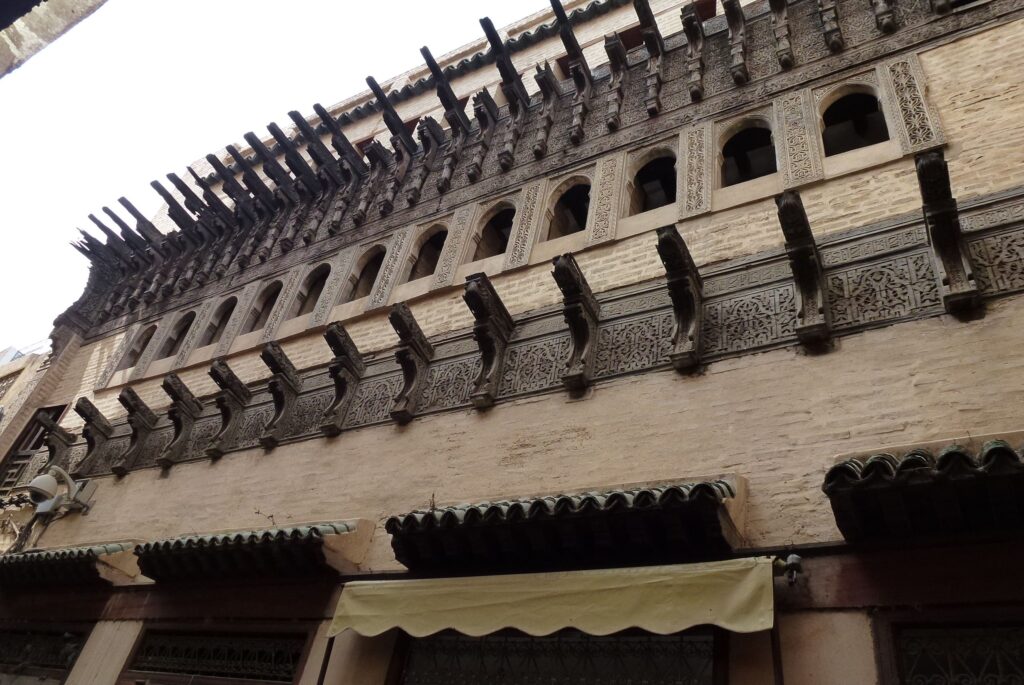
Dar al-Magana, Arabic for “clock house,” is a historical building in Fes, Morocco, commissioned by the Marinid Sultan Abu Inan Faris. It houses a unique weight-powered water clock designed by the muwaqqit Abou al-Hassan Ibn Ali Ahmed Tlemsani, completed on May 6, 1357. Situated opposite the Bou Inania Madrasa, Dar al-Magana is intricately connected to this educational institution.
The clock comprises 12 windows and platforms holding brass bowls. Its mechanism likely involved a small cart moving horizontally behind the twelve doors, driven by weights. One end of the cart connected to a hanging weight, while the other linked to a weight floating on a water reservoir, emptied at regular intervals. Every hour, one door opened, coinciding with the release of a metal ball into a brass bowl below. The protruding rafters above the doors supported a protective roof structure, resembling those of the adjacent Bou Inania Madrasa.
Henna Souk
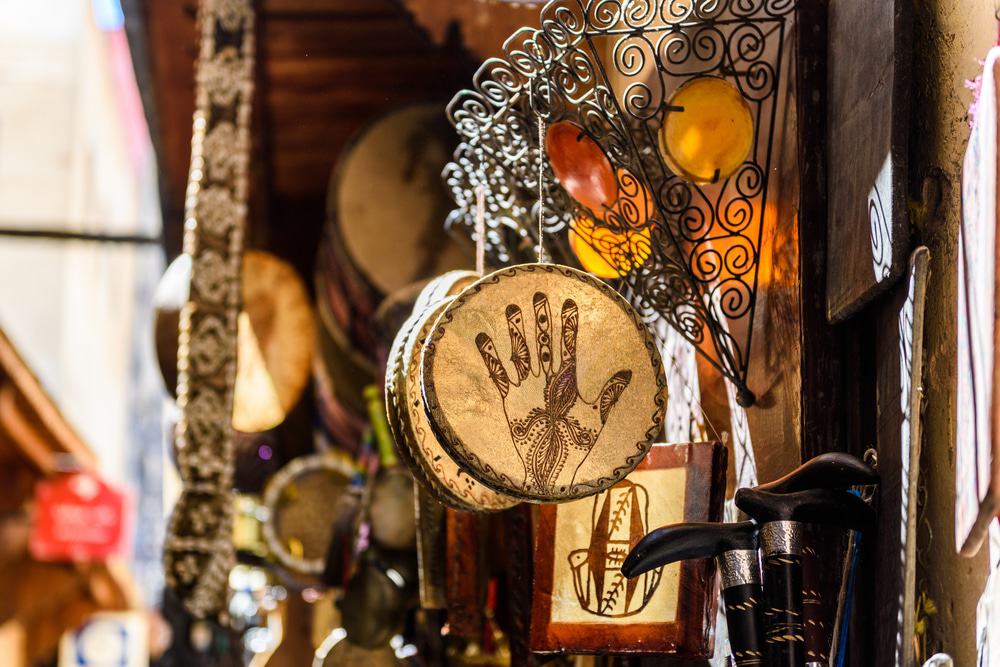
A visit to Fes wouldn’t be complete without exploring the local markets, known as souks. One of the must-visit spots in the Fes medina is the Souk el Henna, also called the market of perfumes and henna. As the name suggests, this market specializes in selling fragrances, toiletries, and henna products.
Here, you’ll find a wide array of items including cosmetics, soaps, perfumes, rose water, spices, pottery, ceramics, tiles, jewelry, utensils, and even bird cages. However, it’s important to exercise caution as some shops in Souk el Henna are rumored to sell items with magical properties or questionable side effects. To ensure a safe shopping experience, stick to products you’re familiar with and avoid anything that seems suspicious.
Despite this, don’t hesitate to explore the various perfumeries in the market, known for offering some of the finest fragrances globally.
Know Before You Go:
- Inform your licensed guide about your shopping preferences to be directed to reputable shops.
- Bargain with the vendors as prices may initially be inflated for tourists.
- Avoid entering shops on your own and be cautious of aggressive sales tactics.
- If you’re accompanied by children, expect them to receive attention and compliments, which is common in Moroccan culture.
Ain Nokbi ceramic Factory
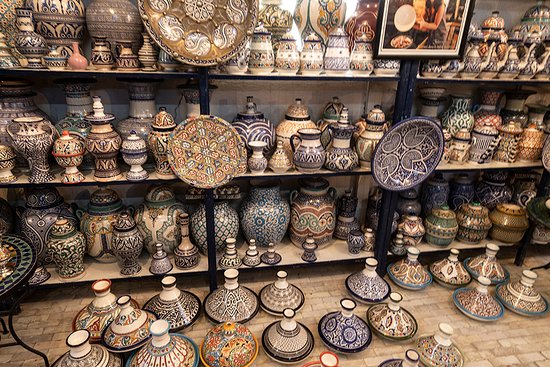
Fes is renowned for producing some of the finest pottery in Morocco, thanks to its high-quality local gray clay. This clay is exceptionally durable, often fired at volcanic temperatures, making the pottery resistant to microwave and dishwasher use. Each piece is meticulously hand-painted, adding to its unique charm.
For those looking to add to their kitchen or dining room collection, there are several options available. Along Talaa Kbira, numerous stores offer high-quality tableware, with Fondouk Tazi being a favorite among locals and visitors alike, boasting a selection of both traditional and modern designs.
Venture further into the medina to the Henna Souk, where you’ll discover a range of pottery adorned with traditional patterns such as the tomato flower, Berber motifs, and embroidery-inspired designs. Serious buyers may opt to visit Ain Nokbi, the industrial quarter, to observe potters at work. Additionally, shops in this area can arrange large shipments, but it’s advisable to personally oversee the packaging to ensure items arrive intact.
Fes Morocco Travel Guide Conclusion
In our Fes Morocco Travel guide conclusion, exploring Fes, Morocco, offers a rich tapestry of experiences, from wandering the ancient medina to discovering hidden gems like the Borj Nord Arms Museum and Ibn Danan synagogue. The city’s vibrant markets, such as Souk el Henna, showcase its rich cultural heritage through fragrances, pottery, and intricate handicrafts. Whether admiring the intricate woodwork of Fondouk el-Nejjarine or marveling at the historic Al-Karaouine University, visitors are immersed in Fes’s storied past.
From the tranquil oasis of Jardin Jnan Sbil to the bustling streets of Place Seffarine, Fes captivates with its blend of tradition and modernity. For an unforgettable journey, Fes Morocco Travel Guide offers a gateway to the heart and soul of this captivating city, ensuring that every visitor experiences the essence of Fes in all its splendor.

